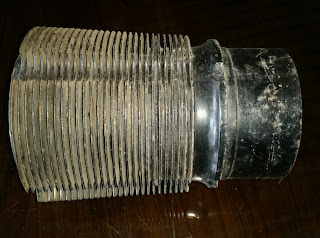Valve
Valve opens and closes cylinder ports. The valves used in aircraft engines are the conventional poppet type. The valves are also typed by mushroom or tulip.
Valve Construction - valves are subjected to high temperatures, corrosion, and operating stresses.
Intake valves operate at lower temperatures than exhaust valves, they can be made of chromic-nickel steel.
Exhaust valves are usually made of nichrome, silchrome, or cobalt-chromium steel because these materials are much more heat resistant.
Valve head has a ground face that forms a seal against the ground valve seat in the cylinder head when the valve is closed.
Face of the valve is usually ground to an angle of either 30° or 45°. In some engines, the intake-valve face is ground to an angle of 30°, and the exhaust-valve face is ground to a 45° angle. Valve faces are often made more durable by the application of a material called stellite. About 1⁄16 inch of this alloy is welded to the valve face and ground to the correct angle.
Stellite is resistant to high-temperature corrosion and also withstands the shock and wear associated with valve operation. Some engine manufacturers use a nichrome facing on the valves. This serves the same purpose as the stellite material.
Valve stem acts as a pilot for the valve head and rides in the valve guide installed in the cylinder head for this purpose.The valve stem is surface hardened to resist wear.
Neck is the part that forms the junction between the head and the stem.
Tip of the valve is hardened to withstand the hammering of the valve rocker arm as it opens the valve.
Machined groove on the stem near the tip receives the split-ring stem keys. These stem keys form a lock ring to hold the valve spring retaining washer in place.
Hollow stems valve partially filled with metallic sodium which is an excellent heat conductor. The sodium melts at approximately 208 °F and the reciprocating motion of the valve circulates the liquid sodium, allowing it to carry away heat from the valve head to the valve stem where it is dissipated through the valve guide to the cylinder head and the cooling fins. Thus, the operating temperature of the valve may be reduced as much as 300° to 400 °F.
Under no circumstances should a sodium-filled valve be cut open or subjected to treatment which may cause it to rupture.Exposure of the sodium in these valves to the outside air results in fire or explosion with possible personal injury.
Valve Construction - valves are subjected to high temperatures, corrosion, and operating stresses.
Intake valves operate at lower temperatures than exhaust valves, they can be made of chromic-nickel steel.
Exhaust valves are usually made of nichrome, silchrome, or cobalt-chromium steel because these materials are much more heat resistant.
Valve head has a ground face that forms a seal against the ground valve seat in the cylinder head when the valve is closed.
Face of the valve is usually ground to an angle of either 30° or 45°. In some engines, the intake-valve face is ground to an angle of 30°, and the exhaust-valve face is ground to a 45° angle. Valve faces are often made more durable by the application of a material called stellite. About 1⁄16 inch of this alloy is welded to the valve face and ground to the correct angle.
Stellite is resistant to high-temperature corrosion and also withstands the shock and wear associated with valve operation. Some engine manufacturers use a nichrome facing on the valves. This serves the same purpose as the stellite material.
Valve stem acts as a pilot for the valve head and rides in the valve guide installed in the cylinder head for this purpose.The valve stem is surface hardened to resist wear.
Neck is the part that forms the junction between the head and the stem.
Tip of the valve is hardened to withstand the hammering of the valve rocker arm as it opens the valve.
Machined groove on the stem near the tip receives the split-ring stem keys. These stem keys form a lock ring to hold the valve spring retaining washer in place.
Hollow stems valve partially filled with metallic sodium which is an excellent heat conductor. The sodium melts at approximately 208 °F and the reciprocating motion of the valve circulates the liquid sodium, allowing it to carry away heat from the valve head to the valve stem where it is dissipated through the valve guide to the cylinder head and the cooling fins. Thus, the operating temperature of the valve may be reduced as much as 300° to 400 °F.
Under no circumstances should a sodium-filled valve be cut open or subjected to treatment which may cause it to rupture.Exposure of the sodium in these valves to the outside air results in fire or explosion with possible personal injury.



Comments
Post a Comment